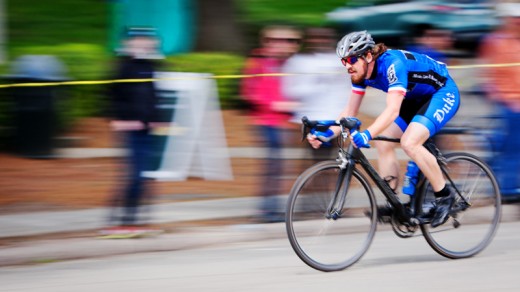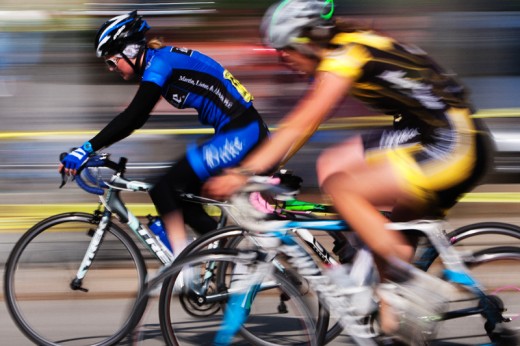Camera Nerd Blog O’ The Week: What’s in My Camera Bag?
I spent most of the day yesterday having a ton of fun photographing amateur, pro, and collegiate cycling at the second annual 9th Street Derby in downtown Durham. This is not a paid gig, so I am free to play, and really wanted to nail down my panning technique and get some shots I could be proud of. Among the four thousand plus frames I shot yesterday, I think there are a few that accomplished my goals!
Because of the magnitude of the editing task ahead of me, I thought I’d stall with a quick “What’s in my bag” blog, inspired by a series that I can’t find now where various pro photographers show and tell their camera bags to give folks an idea of there style and what gear might be suited for what situation. Rather than show you everything, though, I thought I’d start a series where I’ll periodically show how I pack my bag for various different situations. While I have more gear to bring, I generally try to pare it down as much as possible–for the sake of my back and arms, but also because of creative and security considerations (if you get tired of carrying your bag around and put it down somewhere, you’re opening up the possibility of theft).
Anyway, on to the bag, as packed for cycling. Pictured above is everything I took with me for the day at the derby, all packed into a ThinkTank Urban Disguise 50 shoulder bag. When you think sports, you immediately think telephoto lenses, the need for fast focus, and fast frame rates. So, I packed the mainstay 70-200 f/2.8L IS (I have the older version of this lens) and also a 300 f/4L IS, but then I also packed my 16-35 f/2.8L (also a v.1) since some of my favorite cycling photos are wide angle. Last year at the derby, I used a 24-70 f/2.8L (ALSO v.1–do you note a trend here?) and that worked great, but I wanted to see if I could go even wider with Canon’s ultrawide. These lenses were on a 5D mark III and a 1D mark III. Ever since I got the 5D3, the 1D3 has essentially been relegated to backup duty–it’s heavier, has noisier high ISOs, and has smaller file sizes (which can be a great thing, btw). I keep it around for the odd occasion where I might need a deep buffer, 10fps, weather-sealing, a battery that lasts forever, or 1/320th flash sync speed–as it turns out, there are a lot of reasons I keep it around! For the most part, I kept the 16-35 on the 5D3 because the 1D3 has a 1.3 crop and I wanted the full wideness of my lens. Then I had either the 70-200 or the 300 on the 1Dmk3.
All of that is pretty standard stuff, and there were several other photographers at the event with variations on essentially the same kit–there were the Nikon versions, and a PJ there had the 300 f/2.8 instead of the f/4, but in general, pretty similar stuff. The one thing in my bag that the others probably didn’t bring (I didn’t see any others) is the 3-stop neutral density (ND) filter. I know what you’re thinking–“Mark, you’re shooting fast action sports! Those guys are averaging 30+ mph on a tight half mile course! What reason could you possibly have for a neutral density filter which cuts light getting to your lens?!?!?” I see your incredulous face. Well, I’ll tell you–so I can do stuff like this:
In order to get shutter speeds slow enough for panning on a bright sunny day (These were ~1/60th of a second), you need low ISOs and to stop down. If you don’t want t0 (for reasons of DOF) or can’t (the 16-35 only goes to f/22) stop way down, an easy way to get slower shutter speeds is to use an ND filter. I originally bought the 3 stop filter so that I could use wider apertures when shooting with strobes, but it also comes in handy for this sort of stuff.
Rounding out the bag is a microfiber cloth (I wish I could remember where I got that one–it’s my favorite!), extra batteries for each camera, compact flash and SD cards (the SD cards are in the case under the CF cards), and an Induro carbon fiber monopod (which I didn’t end up using, but my sore arms wish I had). Carbon fiber monopods are relatively cheap, very light, and very strong for their size, making them ideal for someone like me who occasionally needs more stability, but almost never uses a tripod. Also, a note about memory–one of the most critical components of my bag was the amount of memory I had packed, as I went from shooting 4,000+ frames at the derby to even more shooting at a concert (see below), with no time in between to dump photos onto a hard drive. With less memory (I actually had even more packed), I could have been in real trouble come concert time.
Later that night, I used the same kit to shoot a concert with a bassoon ensemble at a dimly lit venue. For the concert, though, I switched the lenses to take advantage of the 5D3’s superior noise handling, and I also used the monopod this time.
I will try not to fill my blog with too much of this stuff, but I know it is sometimes interesting to other photographers and to those who are beginning to assemble their kits and looking at what might work. So for those folks, I hope it is interesting and I will try to do more of these from time to time. And, enough stalling–I need to start working on those photos!!!




